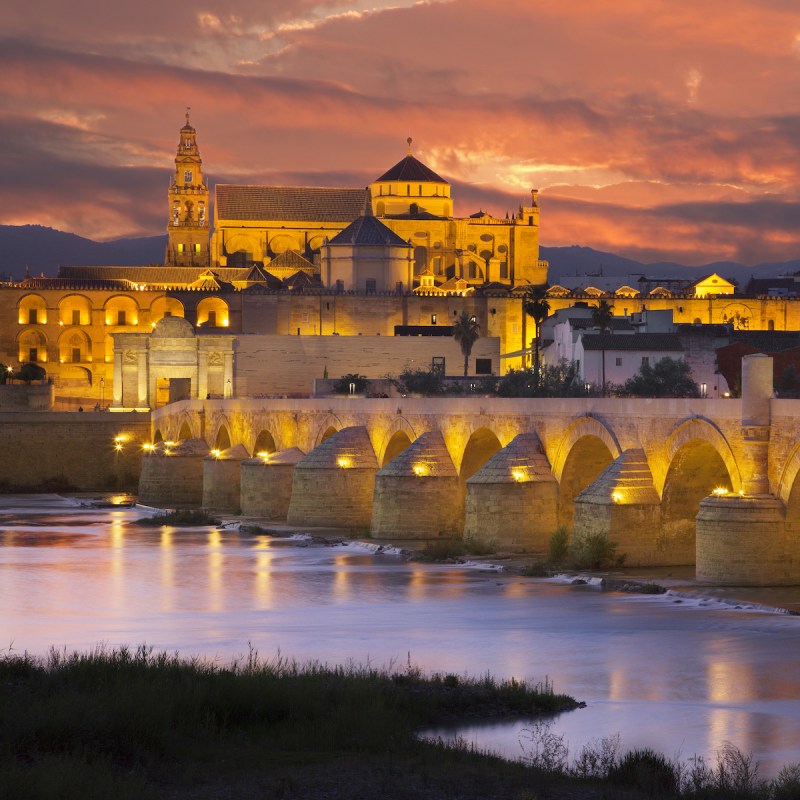
Hot, arid, and culturally vibrant, Andalusia has a sultry climate and an even sultrier reputation. It’s the birthplace of a pair of Spain’s most famous exports — sherry and flamenco — and the producer of two-thirds of the country’s vast olive oil market. The region is also home to 8.4 million people who descend from a blend of ancient cultures. This makes Andalusia prime real estate for a Spanish vacation, where you can enjoy spectacular landscapes, historical attractions, fine food and wine, sunny beaches, and unforgettable entertainment.
Videos by TravelAwaits
As an “honorary” Spaniard — I married into a family from Madrid — I travel around Spain a couple times a year. Andalusia sticks with me for its unhurried atmosphere, its friendliness, its phenomenal cuisine, and its geographical variety, from desertlike plains to sparkling beaches, pine forests that seem to ascend into the clouds, and the striking Sierra Morena and Baetic Cordillera mountain ranges. (The latter gives rise to the Sierra Nevadas, the highest elevation in Spain at about 15,000 feet.)
You’ll find plenty to see and experience in Andalusia thanks to its long history of cultural interplay, beginning with the Indigenous Iberian tribes who were displaced by — and sometimes intermarried with — the Phoenician and Roman colonizers, followed by Germanic conquerors, Jewish settlers, and finally Arab and Berber invaders. The autonomous community is broken up into eight provinces, each named after their capitals: Almería, Cadiz, Cordoba, Granada, Huelva, Jaen, Málaga, and Seville. While capitals are always a good place to start in a new-to-you destination, don’t overlook some of the smaller towns and villages.
Here are some of my favorite places to go in Andalusia.

1. Córdoba
The Mosque-Cathedral of Córdoba is world-famous for its scale and church-in-a-church construction; a Muslim mosque was built atop a Christian basilica and the mosque was later converted to a Catholic cathedral. It’s a must-see.
Córdoba’s history as an Islamic capital gives it a worldly feel, with lots of gorgeous Moorish architecture in the Old Town, plus residential streets packed with whitewashed houses decorated with window boxes of bright flowers.
In addition to the mosque-cathedral, top sights include the castle and gardens of the Alcazar (fortress), the Roman bridge, and Callejón de las Flores — a narrow, bloom-bedecked street that’s the most photographed in the entire city. While it’s not as well-known to American visitors, the Renaissance-era Palacio de Viana is a worthy stop. Besides the 14th-century palace and its multiple gardens, you’ll find 12 patios, all with different designs.
The wine and cuisine in Córdoba is reliably excellent, including red wines from the Montilla-Moriles growing region, and salmorejo, a form of gazpacho made by blending tomatoes with garlic, olive oil, sherry vinegar, and bread, then topping it with chopped boiled egg and/or ham.

2. Huelva
My in-laws love Huelva — the launching pad for Christopher Columbus’s New World explorations — so much, they’ve been vacationing there for decades. In Cádiz province, along the Costa de la Luz (Coast of Light), Huelva is lesser-known than some of southern Spain’s famous beach towns, like Marbella.
Among Huelva’s coastal stretches, the most popular beaches include Punta Umbria, San Miguel, and Nuevo Portil. My favorite is La Bota, about 10 minutes west of Punta Umbria. It’s popular for a different reason: consistent wind and waves make it ideal for windsurfing and give it a wilder feel.
Huelva has some lovely natural areas and walking trails, especially in and around Doñana National Park, a UNESCO World Heritage site. The city is also known for its exceptional fresh seafood. Try grilled ventresca, from the belly of the tuna, or mojama, made from paper-thin slices of tuna cured with salt and served with fried almonds. Be sure to take in fandangos de Huelva, a folkloric dance with music that descends from Moorish styles and Portuguese fado.

3. Seville
The most famous city in Andalusia is also its capital. You’ll find plenty of historic sights in Seville, including the Real Alcazar, an example of Mudéjar architecture so exceptional, it was practically its own character in the fifth season of Game of Thrones. But it’s not the only palace: You can also visit 16th-century Casa de Pilatos, which is adorned in thousands of intricate tiles, or Lebrija Palace, built in the 1600s and home to a fascinating collection of Roman mosaics.
With its sweeping staircases, water features, and tile murals, Seville’s Plaza de Espana might be the prettiest city square in all of Europe. At night, it comes alive with dozens of lights. Seville Cathedral, a UNESCO World Heritage site, is one of the largest and grandest churches in the world.
Seville is said to be the innovator of tapas and the city has more than 3,000 bars for drinks and small plates. Blanca Paloma, in the Triana neighborhood, is a classic that serves excellent seafood tapas, including one of my favorites, boquerones fritos (fried anchovies). Or go for a wider, make-your-own-plate selection at Mercado Lonja del Barranco, which hosts about 20 different food and drink makers. Want more of a sit-down meal? Head to ConTenedor, a modern, slow-food restaurant with plenty of vegan, vegetarian, and gluten-free options.

4. Jerez De La Frontera
While not as famous as Seville, Jerez is still a sizable city but with much less tourist traffic. It’s part of the “Sherry Triangle,” a trio of wine-producing cities that craft the country’s best sherries. For tastings and vineyard tours, you can’t go wrong with bodegas Tío Pepe, Luis Perez, and Lustau.
Then head into downtown, where the wider streets are easier to navigate than in some of Andalusia’s other old towns. Jerez de la Frontera Cathedral — which mixes Gothic, Baroque, and Neoclassical architecture — is located beyond a grove of fragrant orange trees in the center of town. The church’s bell tower, which is actually next door, offers phenomenal views of the city, as long as you don’t mind a 10-minute walk up a spiraling ramp to get there.
At night, flamenco is so plentiful at the city’s bars that you could “flamenco hop” from one to the next. Tabanco el Guitarrón de San Pedro and Tabanco el Pasaje are two of the better-known bars. Or for dinner and a show, head to Tablao Flamenco Puro Arte, a performance venue also known for its tasty menu.

5. Pueblos Blancos Of Andalusia
Andalusia’s whitewashed villages, or pueblos blancos, might seem made for Instagram, but their pale coloring serves several practical purposes. The lime-base paint used is believed to repel insects, make the buildings more resistant to water damage, and reflect sunlight, keeping homes cooler during the soaring heat of summer.
Because these are small towns and villages, don’t expect extensive selections of restaurants, shops, or attractions. Instead, visit a pueblo blanco for its beauty, tranquility, and authentic local culture.
Located on a slope above the Guadalporcún River, Setenil de las Bodegas — near Ronda — is built beneath cliffs, with homes wedged right into the rock. About an hour from Córdoba, Zuheros is a breath of fresh air situated close to the entrance of Sierra Subbética Natural Park. Its castle appears to materialize straight out of the cliff face, and the village is a pristine, wide-open delight.
In quintessentially Mediterranean Frigiliana, in Málaga province, snap pictures along the immaculately maintained streets, then stop for lunch at Plaza de la Iglesia. About 40 minutes northwest of Tarifa, Spain’s southernmost city, lies Vejer de la Frontera. In its medieval quarter, ditch the large hotels for a peaceful atmosphere at Califa Casas’ four new rental homes, just a 5-minute walk from a number of tapas bars and restaurants.

6. Granada
Granada is my husband’s favorite Andalusian city because its 300 days of clear skies and low light pollution make it ideal for stargazing. The Spanish capital of astronomy, the city boasts a number of observatories, some of which, like the excellent Sierra Nevada Observatory, are open to the public.
Get a double-feature of UNESCO in Granada. The Old Town’s world heritage site is comprised of the 9th-century Moorish Alhambra palace and fortress; the Generalife, a country estate of rulers from the Nasrid dynasty; and the Albayzin, a Moorish neighborhood set on a hillside where you can eat at superb restaurants or stay in historic houses converted into inns. Granada’s steep hills can be challenging, so if you have mobility issues, book a guided tour or use the city’s hop on, hop off shuttle.
Granada also has a UNESCO Global Geopark, which features a landscape unlike any other in Spain. Go hiking, cycling, or stargazing, or visit one of the geopark’s excellent paleontology and archaeology museums.

7. Almería
While other travelers flock to Marbella, Andalusia’s swanky resort town, you’ll want to head in the opposite direction toward Almería. Its beaches are still beautiful, if more rugged, and those in Cabo de Gata-Níjar Natural Park offer plenty of opportunities to soak up the sun, dip your toes into crystalline water, and appreciate dramatic seascapes.
Don’t miss a visit to Las Salinas, also in Cabo de Gata. Here, between the sand dunes and the volcanic mountains of the nature park, microalgae that collects atop the salt flats tinges the water bright pink. Las Salinas is a haven for birders; depending on the season, you might spy flamingos, little egrets, gray herons, or the Kentish plover.
Almería has its own impressive Alcazaba and cathedral, both rich in architectural detail. Paseo de Almería, the city’s main street, is packed with boutiques, restaurants, and tapas bars.
For an off-the-beaten-path treat, drive about 30 minutes north of the city to the Tabernas Desert. The only desert in Europe, Tabernas has served as the filming location for a wide variety of blockbusters, from Lawrence of Arabia to numerous spaghetti Westerns and Indiana Jones and the Last Crusade. Visit some of the still-standing film sets, including the Mini Hollywood Western Theme Park.

Know Before You Go
Andalusia is a melting pot — both figuratively and literally. Avoid visiting from June through mid-September, when temperatures soar upwards of 100 degrees, and especially August, when it seems like all of northern Europe descends on its beaches. Instead, plan a trip in late September through mid-December, or late March through early June, when temperatures are mild, in the 60s and 70s most days. Late December through mid-March is cooler, generally in the high 40s to low 60s. But in a place with 3,000 hours of sunshine per year, you’ll still feel plenty toasty.

